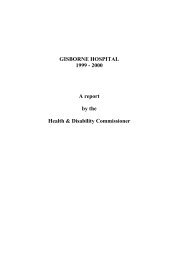09HDC01565 - Health and Disability Commissioner
09HDC01565 - Health and Disability Commissioner
09HDC01565 - Health and Disability Commissioner
You also want an ePaper? Increase the reach of your titles
YUMPU automatically turns print PDFs into web optimized ePapers that Google loves.
Opinion <strong>09HDC01565</strong><br />
night <strong>and</strong> early morning. This is what department <strong>and</strong> patient protocols are for…‖. Dr<br />
E does not consider there was any lack of supervision on his part.<br />
164. Dr E states that ―there is no clear evidence that [Mr A] died of a respiratory event, <strong>and</strong><br />
[…] it could equally have been a (sudden) cardiac or other event‖. Dr E states there is<br />
―definitely no consensus amongst the treating physicians with the [CDHB‘s] RCA<br />
opinion of a possible respiratory event‖.<br />
Dr F<br />
165. Dr F submits there was no indication that there was any confusion with regard to his<br />
postoperative instructions, <strong>and</strong> as such, he does not consider he should have been<br />
expected to clarify his instructions in this specific case. He states that in his<br />
experience it is usual practice for postoperative orders to be followed if there is a<br />
perceived conflict with the unit‘s protocol, ―that is, where a protocol is expected to be<br />
followed, instructions directing staff to follow the specific protocol would normally<br />
be prescribed‖.<br />
166. Dr F states that while he accepts the criticism regarding the lack of specific<br />
instructions in the postoperative orders, he considers ―it is a reasonable expectation of<br />
all medical staff that regular general/vital observations would be performed in all<br />
postoperative patients regardless of whether they are on a PCA or have had cranial<br />
surgery‖.<br />
167. Dr F also notes his concern regarding the fact that Mr A was found with no oxygen<br />
saturation monitor attached <strong>and</strong> with the monitor switched off. In these circumstances,<br />
he states, it is uncertain ―whether specific postoperative instructions would have<br />
changed or prevented the outcome as prescribed parameters could never have<br />
triggered an alert‖.<br />
168. Dr F notes that he is pleased to hear about the new measures <strong>and</strong> monitors that have<br />
been put in place at CDHB. He considers the ―single most important change, which is<br />
indispensable, is the reinforcement of continuous nursing (including h<strong>and</strong>over within<br />
the [SCU])‖.<br />
RN Ms I<br />
169. RN Ms I‘s legal counsel, Mr P, notes that RN Ms I conducted many of Mr A‘s<br />
observations on an hourly basis, <strong>and</strong> she was observing him regularly. Mr P submits<br />
that ―RN [Ms I‘s] failure to record [Mr A‘s] respiratory rate on no more than a few<br />
occasions had no influence on the outcome of this tragedy‖ <strong>and</strong> was not a causative<br />
factor.<br />
170. Mr P states that the advice of my nursing expert, Janet Hewson, that respiratory rates<br />
should be recorded at all times, is accepted. He submits that any disapproval of RN<br />
Ms I in relation to this matter would be mild, given the other observations undertaken<br />
by RN Ms I.<br />
29 5 September 2012<br />
Names have been removed (except Canterbury DHB <strong>and</strong> the experts who advised on this case) to<br />
protect privacy. Identifying letters are assigned in alphabetical order <strong>and</strong> bear no relationship to the<br />
person’s actual name.
















